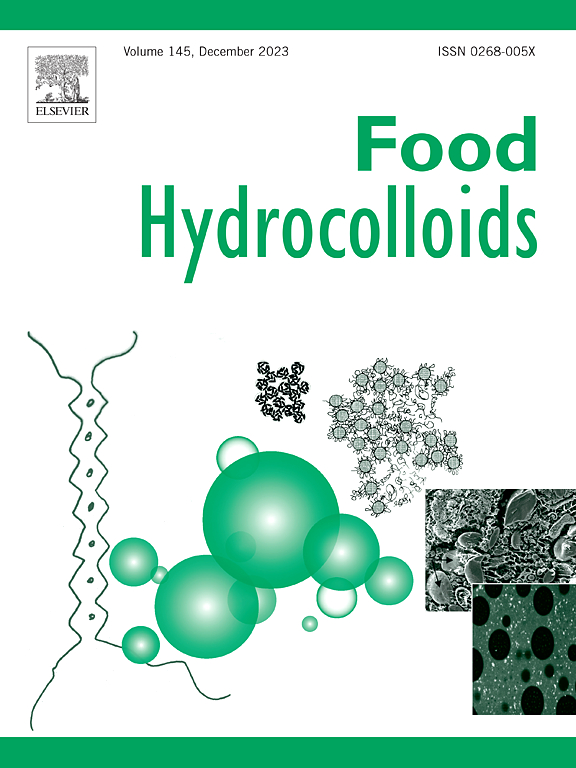Novel rutin-casein composites as functional dry ingredients for the delivery of high concentration of rutin in dairy beverages: in vitro bioaccessibility, cytotoxicity, absorption, and intestinal barrier integrity
IF 11
1区 农林科学
Q1 CHEMISTRY, APPLIED
引用次数: 0
Abstract
Rutin, a flavonoid with antioxidant and anti-inflammatory properties, has poor solubility (highly hydrophobic) and is unstable during gastrointestinal digestion, limiting its use in functional foods. To overcome this challenge, we developed two rutin-caseinate composites (RCC1 and RCC2) as delivery vehicles for incorporation into functional foods/beverages. While both systems deliver rutin at high concentration, they differ in terms of methodology, loading capacity, and applications. The gastrointestinal stability, bioaccessibility, and antioxidant potential of these delivery systems, both alone and incorporated into a functional dairy beverage (flavoured milk), were assessed. We also examined the cytotoxicity, absorption, and intestinal barrier integrity of rutin using an intestinal epithelial cell model. The bioaccessibility of rutin from RCC1 and RCC2 was found to be 63 % and 45 %, respectively, compared to untreated rutin (UR), which was undetectable due to precipitation. Additionally, RCC2 exhibited superior intestinal barrier integrity with a trans-epithelial electrical resistance (TEER) value of 1655 Ω/cm2 for 24 h , outperforming both RCC1 (1384 Ω/cm2) and UR (915 Ω/cm2). Intracellular antioxidant activity was significantly higher for both composites in terms of lower relative fluorescent units (RFU); 44 RFU for RCC1 and 42 RFU for RCC2, compared to 63 RFU for UR, demonstrating their enhanced protective effects. Caco-2 cell viability of the composite samples was higher, with no cytotoxicity observed compared to UR, confirming their safety. When incorporated into milk, both systems improved rutin bioaccessibility, with RCC1 showing a stronger antioxidant response (87 RFU) than RCC2 (100 RFU) and untreated rutin (140 RFU) during extended incubation. These findings suggest that both RCC1 and RCC2 are stable, soluble, and safe for physiological systems. Their incorporation into dairy matrices enhances rutin bioaccessibility and antioxidant potential, making them a promising approach for functional foods development.

新型芦丁-酪蛋白复合材料作为乳饮料中高浓度芦丁的功能性干燥成分:体外生物可及性、细胞毒性、吸收和肠道屏障完整性
芦丁是一种具有抗氧化和抗炎特性的类黄酮,但其溶解度差(高度疏水),在胃肠道消化过程中不稳定,限制了其在功能食品中的应用。为了克服这一挑战,我们开发了两种芦丁-酪蛋白酸酯复合材料(RCC1和RCC2)作为纳入功能性食品/饮料的运载工具。虽然这两种系统都能提供高浓度的芦丁,但它们在方法、负载能力和应用方面有所不同。评估了这些输送系统的胃肠道稳定性、生物可及性和抗氧化潜力,无论是单独使用还是合并到功能性乳制品饮料(风味牛奶)中。我们还使用肠上皮细胞模型检测了芦丁的细胞毒性、吸收和肠屏障完整性。RCC1和RCC2对芦丁的生物可及性分别为63%和45%,与未处理的芦丁(UR)相比,由于沉淀而无法检测到。此外,RCC2表现出优异的肠道屏障完整性,24小时的跨上皮电阻(TEER)值为1655 Ω/cm2,优于RCC1 (1384 Ω/cm2)和UR (915 Ω/cm2)。在较低的相对荧光单位(RFU)方面,两种复合物的细胞内抗氧化活性显著较高;RCC1为44 RFU, RCC2为42 RFU,而UR为63 RFU,表明它们的保护作用增强。复合样品的Caco-2细胞活力较高,与UR相比无细胞毒性,证实了其安全性。当加入牛奶中时,两种体系都提高了芦丁的生物可及性,在延长的孵育期间,RCC1的抗氧化反应(87 RFU)比RCC2 (100 RFU)和未处理的芦丁(140 RFU)更强。这些发现表明,RCC1和RCC2在生理系统中都是稳定的、可溶的和安全的。将它们掺入乳制品基质中,可提高芦丁的生物可及性和抗氧化潜力,使其成为功能食品开发的一种有前景的方法。
本文章由计算机程序翻译,如有差异,请以英文原文为准。
求助全文
约1分钟内获得全文
求助全文
来源期刊

Food Hydrocolloids
工程技术-食品科技
CiteScore
19.90
自引率
14.00%
发文量
871
审稿时长
37 days
期刊介绍:
Food Hydrocolloids publishes original and innovative research focused on the characterization, functional properties, and applications of hydrocolloid materials used in food products. These hydrocolloids, defined as polysaccharides and proteins of commercial importance, are added to control aspects such as texture, stability, rheology, and sensory properties. The research's primary emphasis should be on the hydrocolloids themselves, with thorough descriptions of their source, nature, and physicochemical characteristics. Manuscripts are expected to clearly outline specific aims and objectives, include a fundamental discussion of research findings at the molecular level, and address the significance of the results. Studies on hydrocolloids in complex formulations should concentrate on their overall properties and mechanisms of action, while simple formulation development studies may not be considered for publication.
The main areas of interest are:
-Chemical and physicochemical characterisation
Thermal properties including glass transitions and conformational changes-
Rheological properties including viscosity, viscoelastic properties and gelation behaviour-
The influence on organoleptic properties-
Interfacial properties including stabilisation of dispersions, emulsions and foams-
Film forming properties with application to edible films and active packaging-
Encapsulation and controlled release of active compounds-
The influence on health including their role as dietary fibre-
Manipulation of hydrocolloid structure and functionality through chemical, biochemical and physical processes-
New hydrocolloids and hydrocolloid sources of commercial potential.
The Journal also publishes Review articles that provide an overview of the latest developments in topics of specific interest to researchers in this field of activity.
 求助内容:
求助内容: 应助结果提醒方式:
应助结果提醒方式:


